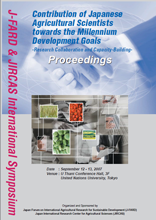Roles of agricultural research for achieving development goals

During the 20th century the world population has increased from 1.2 billion to more than 6 billion, but
the food production has increased even more. The per capita availability of food has increased in that period.
The increased productivity per ha explains 80% of the increased agricultural production. That productivity
rise per ha is based on good insight in the functioning of agricultural systems, and better use of external
inputs.
Agricultural research has played a pivotal role in the mega-trends of the 20th century that characterize
agriculture and management of natural resources. These trends are:
1. Increased productivity per ha, per man-hour and counter intuitively per kg of external inputs such as
nitrogen or crop protection measures.
2. Broadening of the objectives of agriculture. Natural resource management, minimization of
environmental side effects, and maintaining the landscape are additional objectives.
3. Change in the character of agriculture production and farming. Skills and traditional customs are
replaced by industrial way of production, guaranteeing quality of products and production processes.
4. Vertical integration is fully adopted. From the soil to the shelf, from the spade to the plate are
nowadays the buzzwords. Supply driven character has increased and in the same time the lateral
relations were not neglected. That has increased effi ciency and effi cacy of use of natural resources
and external inputs.
5. The attention for food, nutrition and other aspects have increased considerably. That has led to more
attention for functional foods, but also to more research on micro nutrients that play a major role in
strengthening the food situation in the developing world.
Those mega-trends take place everywhere and are most visible in the developed world but affect the
development processes in the developing world intensively. The universities and knowledge institutes of
the south and north play an important role in these developments. The Consultative Group on International
Agricultural Research has contributed the last 40 years to the further development of agriculture and has laid
the basis for increased agricultural productivity and food security.
The institutes of the CGIAR have gone through an evolution of change. The original institutes were
dominated by plant breeding, but through various stages they are now oriented to global challenges making
use of the best of agricultural sciences at fundamental and applied levels. The 15 centers function as nodes
in a network of international agricultural research and played a major role in the green revolution in Asia
and Latin America and see it as their major task to fulfi ll the promise and potential of African agriculture.
Increased agricultural productivity and food security in Africa are the major tasks for agricultural research
in the coming decade. That is possible but it requires an enabling environment, appropriate investments and
removal of many limiting factors and inertia.
The way that may be achieved is described by the InterAcademy Council in its report of 2004 and the
Hunger Taskforce of the United Nations.
| 刊行年月日 | |
|---|---|
| 作成者 | Rudy Rabbinge |
| 公開者 | Japan International Research Center for Agricultural Sciences |
| オンライン掲載日 | |
| 号 | 2007 |
| 開始ページ | 24 |
| 終了ページ | 31 |
| 権利 | Japan International Research Center for Agricultural Sciences |
| 言語 | eng |
